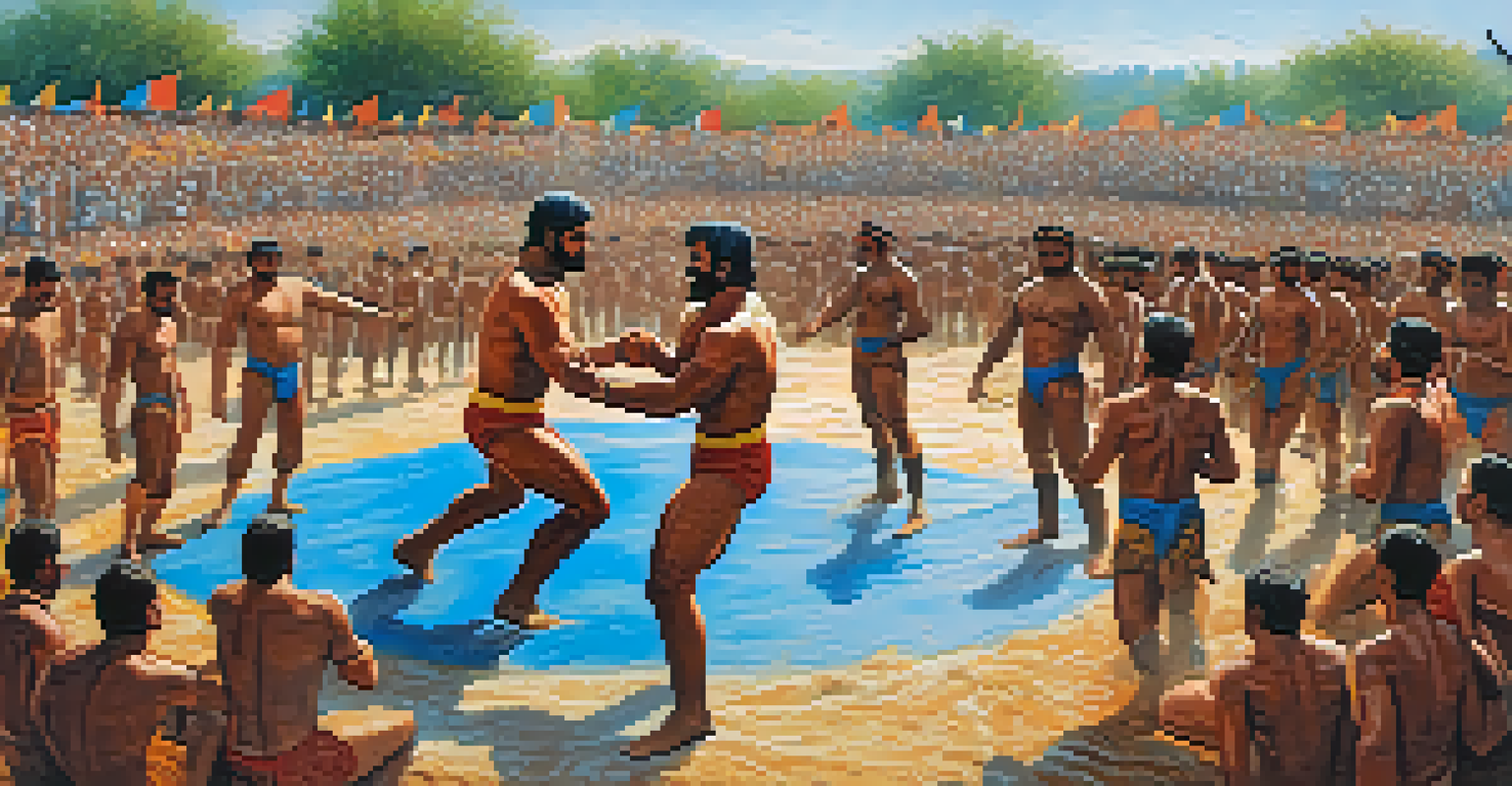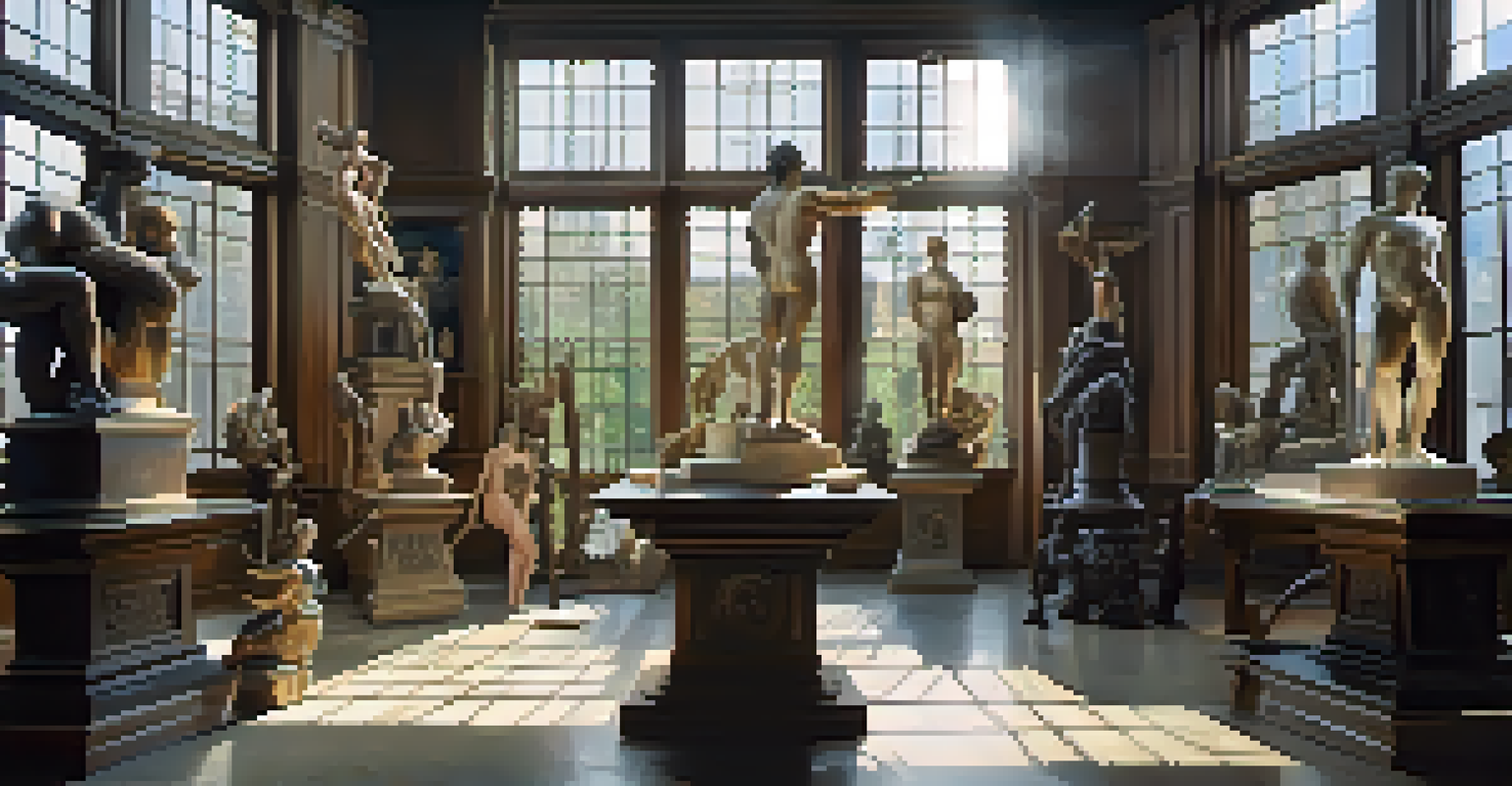Historical Roots of Bodybuilding in Different Cultures

The Ancient Greeks: Birthplace of Physical Culture
Bodybuilding traces its roots back to ancient Greece, where physical fitness was celebrated as an essential aspect of life. The Greeks valued the human body, viewing it as a canvas for artistic expression and strength. This appreciation culminated in the Olympic Games, where athletes showcased their physical prowess and sculpted physiques, emphasizing the importance of training and discipline.
Physical fitness is not only one of the most important keys to a healthy body, it is the basis of dynamic and creative intellectual activity.
In their quest for the ideal form, the Greeks developed various training techniques, including weightlifting and calisthenics. These methods were not just for competition; they were integral to military training and everyday life. The Greeks’ love for the body extended to art, where sculptures depicted the perfect human form, influencing future generations’ perceptions of fitness and beauty.
This cultural reverence for the body laid the groundwork for modern bodybuilding. The principles of balance, symmetry, and strength from ancient Greece continue to influence contemporary training regimens. As we explore bodybuilding’s evolution, the Greeks remain a pivotal point in understanding how cultural values shape fitness practices.
Strongmen of the East: Indian Wrestling Traditions
In India, wrestling, known as Kushti, has ancient roots and is deeply intertwined with the culture. Wrestlers, or Pehlwans, train rigorously in traditional mud pits, focusing not only on strength but also on agility and technique. This form of training has existed for centuries, emphasizing the importance of physical fitness in Indian society.

Kushti combines physical training with a holistic lifestyle, including a nutritious diet often rich in dairy and whole grains. The wrestlers follow a strict regimen that includes not just wrestling but also various strength-building exercises and meditation. This blend of physical and mental discipline mirrors the essence of bodybuilding as we know it today.
Ancient Greeks Shaped Fitness Culture
The Greeks' celebration of the human body and their training techniques laid the groundwork for modern bodybuilding.
The legacy of Indian wrestling showcases how cultural practices shape the approach to strength training. As we recognize the global influences on bodybuilding, Kushti stands out as a testament to the dedication and unique methodologies that exist across different societies, contributing to the diverse landscape of fitness.
Egyptian Influence: From Hieroglyphs to Modern Training
Ancient Egypt provides fascinating insights into early bodybuilding practices through its art and cultural artifacts. Hieroglyphs depict muscular figures engaged in various physical activities, suggesting that strength and fitness were valued in Egyptian society. This admiration for the human form is evident in the sculptures and paintings that celebrate athleticism.
Strength does not come from physical capacity. It comes from an indomitable will.
The Egyptians practiced various forms of physical training, which included wrestling and other strength-oriented exercises. These activities were often linked to religious rituals and military preparation, emphasizing the dual significance of fitness in both daily life and spiritual practices. The focus on building strength and endurance reflects early principles that continue to resonate in modern bodybuilding.
Today, the legacy of Egyptian fitness can be seen in how we appreciate the artistry of muscle development. Their historical emphasis on the aesthetic and functional aspects of the body contributes to our understanding of bodybuilding as not just a sport but an expression of cultural identity and human achievement.
The Renaissance: Reviving Classical Ideals of Strength
The Renaissance marked a significant turning point in the appreciation of the human body, influenced largely by the rediscovery of classical ideas from Greece and Rome. Artists and scholars began to emphasize human anatomy and physicality, leading to a renewed interest in fitness and strength training. Sculptures and paintings from this era often reflected the muscular bodies of ancient heroes, inspiring a cultural revival of bodybuilding ideals.
This period saw the emergence of strongmen who showcased their physical prowess through feats of strength, captivating audiences across Europe. These performers often drew inspiration from ancient techniques, using their bodies as their primary tool for entertainment. This blend of art and physicality helped cement the idea that strength could be both functional and beautiful.
Cultural Practices Influence Bodybuilding
Traditional strength training methods, like Kushti in India and Sumo in Japan, showcase the diverse cultural approaches to fitness.
The Renaissance's impact on bodybuilding is profound, as it laid the groundwork for more organized forms of strength training in the centuries to come. As we see the evolution of bodybuilding from this era, it becomes clear how cultural shifts can redefine our relationship with the body and fitness.
The Birth of Modern Bodybuilding in the 19th Century
The 19th century was a pivotal era for bodybuilding, marked by the rise of physical culture movements in Europe and the United States. Figures like Eugen Sandow, often hailed as the father of modern bodybuilding, began to popularize the idea of building muscle for aesthetic purposes. Sandow's performances showcased not only strength but also the beauty of the human physique, captivating audiences and inspiring a generation.
As bodybuilding gained popularity, the establishment of gyms and fitness clubs became more common. These spaces provided individuals with access to weights and training equipment, allowing people to pursue their fitness goals more effectively. The commercial aspect of bodybuilding began to flourish, with competitions and events becoming a staple in the fitness community.
This period also saw the introduction of bodybuilding competitions, which celebrated the sculpted physiques of participants. The format of these contests set the stage for the modern bodybuilding scene we know today, emphasizing the importance of aesthetics alongside strength. The 19th century truly represents the birth of bodybuilding as a distinct cultural phenomenon.
Cultural Variations: Bodybuilding Around the World
Bodybuilding has evolved uniquely across different cultures, reflecting local values and practices. In Japan, for example, the traditional sport of Sumo emphasizes a different kind of strength and physique, showcasing the cultural significance of body size and power. Meanwhile, in Brazil, the rise of fitness culture has led to a focus on aesthetics, with many individuals striving for a lean, toned appearance.
In Africa, traditional strength training often involves community practices that prioritize functional strength over aesthetics. Activities such as lifting heavy objects in daily life and participating in communal games reflect a connection to cultural heritage and physical prowess. This blend of practicality and cultural identity shapes how bodybuilding is perceived and practiced in various regions.
Future Trends in Bodybuilding
Advancements in technology and a focus on holistic health are transforming bodybuilding into a more inclusive and balanced practice.
These cultural variations highlight the rich tapestry of bodybuilding as a global phenomenon. Understanding these differences not only broadens our appreciation for the sport but also emphasizes the importance of respecting diverse approaches to fitness and strength training.
The Future of Bodybuilding: Trends and Innovations
As we look ahead, the future of bodybuilding is poised to evolve with advancements in science and technology. The integration of fitness apps, wearable technology, and personalized training programs is making it easier for individuals to track their progress and achieve their goals. This technological shift is democratizing fitness, allowing more people to engage in bodybuilding regardless of their background or experience level.
Moreover, there is a growing awareness of health and wellness, leading to a more holistic approach to bodybuilding. Individuals are increasingly focusing on nutrition, mental health, and recovery as integral components of their fitness journey. This shift signifies a move away from purely aesthetic goals toward a more balanced and sustainable understanding of bodybuilding.

In this ever-changing landscape, it's crucial to recognize the historical roots that have shaped bodybuilding into what it is today. By appreciating the diverse influences from various cultures, we can foster a more inclusive and innovative future for bodybuilding, ensuring that it remains a vibrant and evolving aspect of human expression and physical fitness.